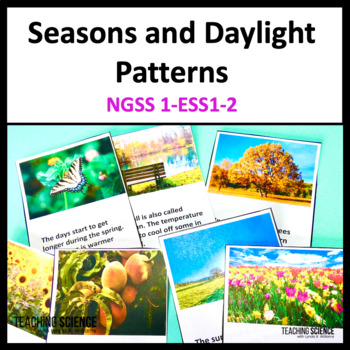Seasons - Daylight Patterns - Motion of the Sun and Earth - NGSS 1-ESS1-2
- Zip
What educators are saying
Also included in
- First Grade Science Bundle for NGSS. This NGSS first grade science bundle is a year’s worth of science for first grade. It covers all the NGSS standards for first grade. Hands-on science, great labs, and interesting activities for first-grade science, discounted in the first-grade science bundle. SaPrice $41.52Original Price $51.90Save $10.38
- This Utah SEEd first grade bundle covers all the standards for the year for the Utah SEEd for first grade. Covers all Utah SEEd standards for first grade. You save 20% by purchasing this bundle. You save time by purchasing this from someone who understands Utah SEEd. Would you like to know more abouPrice $37.92Original Price $47.40Save $9.48
Description
Seasons: Different times of year have different amounts of sunlight. There are seasonal patterns of the motion of the Sun and Earth. Students will learn about the four seasons, and how the revolution of the Earth around the Sun affects the 4 seasons. Students will love these science activities on seasons!
This resource includes:
- labs
- lesson plans
- age-appropriate worksheets
- puzzles for vocabulary
- word wall words
- a slide show.
This resource is designed to meet the NGSS standard:
1-ESS1-2. Make observations at different times of year to relate the amount of daylight to the time of year. Clarification Statement: Emphasis is on relative comparisons of the amount of daylight in the winter to the amount in the spring or fall.] Assessment Boundary: Assessment is limited to relative amounts of daylight, not quantifying the hours or time of daylight.
And Utah SEEd for 1st Grade
1.1: SEASONS AND SPACE PATTERNS Seasonal patterns of motion of the Sun, Moon, and stars can be observed, described, and predicted. These patterns may vary depending on the region, location, or time of year.
Utah SEEd
Standard 1.1.2 Obtain, evaluate, and communicate information about the patterns observed at different times of the year to relate the amount of daylight to the time of year. Emphasize the variation in daylight patterns at different times of the day and at different times of the year. Examples could include varying locations and regions throughout the state, country, and world. (ESS1.B)
Perfect for first-grade science! If you have questions about my resources please contact me at lywilliams1@gmail.com
* My resources are secure and not editable for copyright reasons.
These resources are created by Lynda R. Williams at Teaching Science
Follow me and get news of my new resources. Each new resource is discounted by 50% for the first 24 hours!
Save 20% by purchasing in the Year Long Bundle for NGSS First Grade
Save 20% by purchasing in the Year-Long Bundle for Utah SEEd First Grade
Please see my other resources for first-grade science:
Sun and Moon Patterns That Can Be Predicted NGSS 1-ESS1-1
Designing a Solution to a Human Problem by Mimicking an Animal or Plant Part
Animals and Their Babies First Grade NGSS 1-LS1-2 and 1-LS3-1







